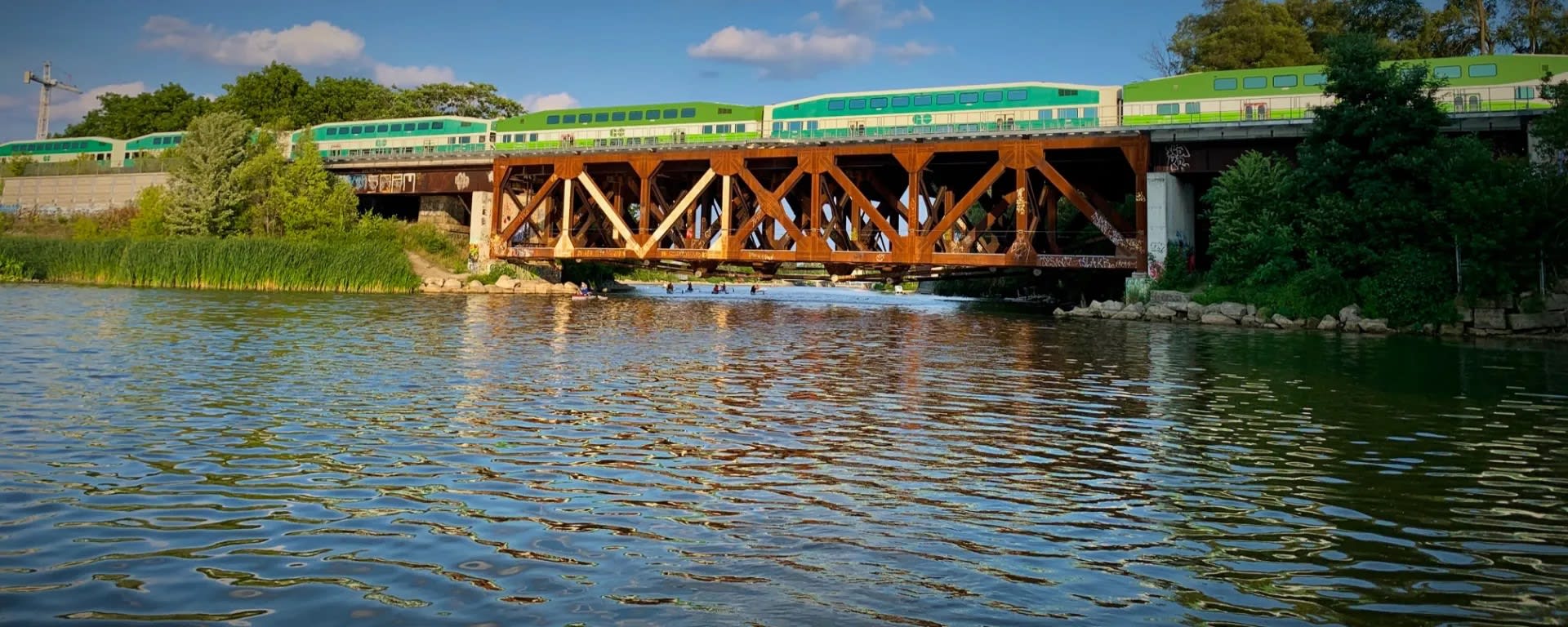Killer selfie? Taking photos on tracks isn't worth the risk
Recent incidents of dangerous behaviour near GO Train tracks is a reminder about the consequences.
Sep 1, 2020
Standing underneath a rail bridge on a recent blazing hot day, Transit Safety St. Sgt. Sue Milos points to a truss that spans across a Mississauga river.
“That’s where they jump from,” she indicates while pointing to the centre of the bridge, shaking her head. “We understand people are staying close to home this summer and looking for things to do, but leaping off a rail bridge is not just illegal, it’s also incredibly dangerous.”
The 22-year transit safety veteran believes there’s never a thrill worth potentially paying the ultimate price for, and she notes this particular one also comes with a steep financial penalty: a maximum fine of $5,000.
“High speed trains are moving through this area all the time,” Milos said. “Some people think they’ve checked our GO timetables so it’s fine, but the reality is there’s a lot of train traffic that isn’t publicly posted.”
Or, as they saying goes among Milos and her fellow transit safety officers: train time is anytime.
Not only is trespassing on a rail bridge illegal and carries a maximum fine of $5,000, it’s also extremely dangerous. (Photo: Matt Llewellyn)
So far this year, GO Transit Special Constables have been called to this particular location more than 40 times for reports of people jumping off the bridge into the cool shallow water below, all in the name of a good time.
Milos says that’s more than any other summer in recent memory. During those calls, her officers have spoken to some 100 people about the dangers and they’ve also laid 15 charges.
While rail bridges have been an area of particular concern, Transit Safety Officers have also been reporting a number of other alarming incidents in recent weeks, many of them involving young people taking unnecessary risks.
Two weeks ago, a Peel Police officer in the area of Lisgar GO Station in Mississauga spotted two young women lying across the rail tracks. Perhaps even more stunning: they were apparently doing so willingly in an effort to take pictures for social media.
Then last week, a young man was spotted hopping onto the track at Bloor GO Station in an effort to catch a train – a decision that could have easily cost him his life if the train reversed to realign with the platform.
“There is nothing harder on a family, or our staff, then hearing the news about a preventable tragedy that’s happened along our tracks,” said Insp. Steve Weir, manager of GO Transit’s Safety Operations. “Worst of all, when it involves the family of a young person.”
Weir recalls one particularly tragic incident involving a 17-year-old boy, which he says has stuck with him for more than seven years.
Michael Newnham (right, pictured with his father) was a grade 12 student at Lorne Park Secondary School in Mississauga. He was killed by a train after getting his foot stuck in the tracks near his home. (Operation Lifesaver photo)
Back in 2013, Michael Newnham, a popular high school student and hockey player, was on his way home from a friend’s house when he tripped and fell on the tracks near Lorne Park Road in Mississauga. His foot got stuck and he was fatally struck by a train.
“It’s that kind of case that really affects our officers the most,” Weir said. “For many of them, it’s this kind of needless tragedy that sits in the back of their minds. I think partly that is because of how relatable these tragedies are as a parent.”
Operation Lifesaver is a national organization that was setup back in 1981 in partnership with Canada’s railway companies and Transport Canada. It’s dedicated to stopping track tragedies right across the country by educating Canadians about the dangers of trespassing on rail corridors, level crossings and other rail infrastructure.
According to the organization, already this year there have been more than 100 serious incidents involving people and trains on federally regulated railways. Thirty-four of those have been deadly, including 11 here in Ontario that were specifically related to people trespassing on tracks.
“The increase in trespassing incidents this year is very concerning,” said Sarah Mayes, National Director of Operation Lifesaver Canada. “Whether people are chasing ‘likes’ by taking photos on the tracks, or thrill-seeking on railway bridges, it’s a bad idea. I’m sure the 2,100 North Americans who were killed or seriously injured in rail incidents last year would say the same thing: don’t risk it.”
Back at the bridge, Milos looks over the water at some nearby homes.
“We all have a role to play in keeping our rail corridors safe,” she said. “We always appreciate when a community member sees something and says something by calling 911 or us.”
And, she adds, she would rather have someone make that call rather than making a heartbreaking one to your family.
Metrolinx encourages everyone to program the 24-hour GO Transit Safety Dispatch number into their phones: 1-877-297-0642. In case of an urgent life-threatening emergency, you should always call 911 first.
by Matt Llewellyn Spokesperson
